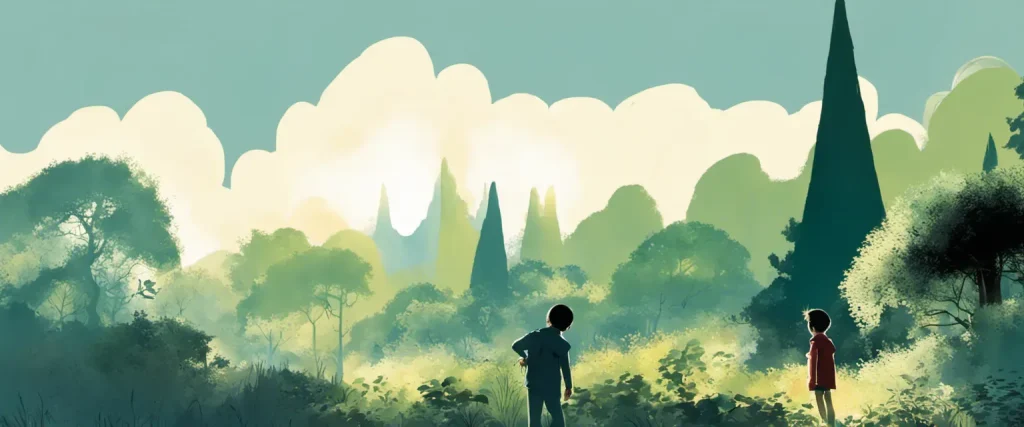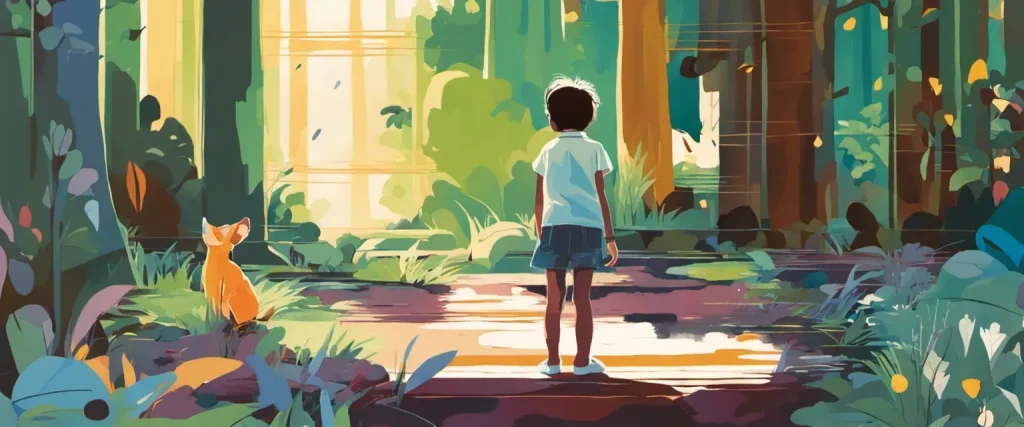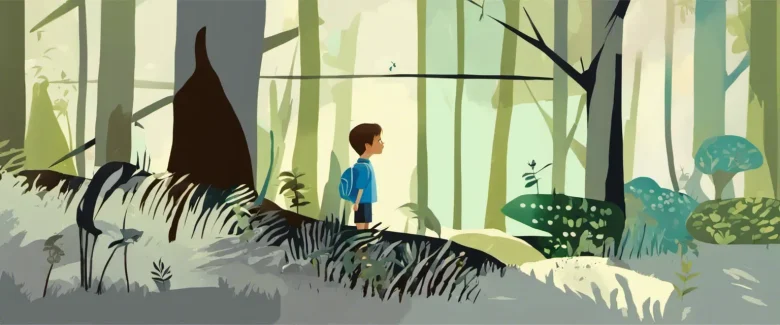In “Last Child in the Woods,” Richard Louv explores the growing disconnect between children and the natural world. This groundbreaking book sheds light on the psychological, physical, and spiritual implications of this phenomenon, and offers insightful solutions to reconnect children with nature. Richard Louv, an esteemed journalist and author, is renowned for his advocacy on the importance of nature and its beneficial effects on both children and adults.
Chapter 1: Introduction
Chapter 1: Introduction of “Last Child in the Woods” by Richard Louv sets the stage for the exploration of the issue of nature-deficit disorder, a term coined by the author. The chapter begins with the author’s anecdotal account of a family trip to San Diego, where he noticed a lack of connection to the natural world among the children. This observation serves as a catalyst for Louv’s investigation into the diminishing presence of nature in the lives of children.
Louv argues that children today are experiencing a widening gap between themselves and the natural environment. He presents evidence supporting the claim that children are spending more time indoors, engaged in activities such as video games, television, and the internet, leading to a disconnection from nature. This detachment, he suggests, has alarming consequences for their physical, mental, and emotional well-being.
Furthermore, the chapter delves into the factors that have contributed to this separation from the wilderness. Louv explores the fear-based factors that have led parents and society to shield children from outdoor exploration, ranging from increased crime rates to media sensationalism. Additionally, he highlights the role of organized sports and structured activities in occupying children’s time and crowding out unstructured nature play.
Louv’s central argument is that this lack of exposure to nature has adverse effects on children’s development, including attention disorders, obesity, and a diminished sense of wonder and stewardship of the natural world. He emphasizes the importance of environmental education and the need for parents, educators, and policymakers to prioritize and provide opportunities for children to experience and connect with nature.
In conclusion, Louv sets the stage for his exploration of nature-deficit disorder, highlighting the changing relationship between children and the natural world. He calls for a renewed focus on reconnecting children with nature, recognizing its essential role in their physical, emotional, and intellectual growth.
Chapter 2: Nature-Deficit Disorder
Chapter 2: Nature-Deficit Disorder in the book “Last Child in the Woods” by Richard Louv explores the concept of children’s disconnection from nature and the potential consequences it may have on their well-being. Louv introduces the term “Nature-Deficit Disorder” to describe this phenomenon.
The chapter firstly highlights the dramatic decrease in the amount of time children spend outdoors compared to previous generations. Factors such as the rise of technology, the fear of stranger danger, and increased emphasis on academics have contributed to this decline. As children spend less time in nature, they miss out on the physical and mental health benefits associated with outdoor activities.
Louv argues that the reduction in nature experiences can lead to a variety of issues, including obesity, attention disorders, and depression among children. He bases his argument on scientific studies, such as the positive effects of exposure to nature on stress reduction and the calming effects of the natural environment on children diagnosed with ADHD.
The author emphasizes the importance of connecting children with nature, believing it to be vital for their development. He proposes various solutions, such as incorporating more outdoor education into the school curriculum, creating green spaces within urban environments, and encouraging parents to prioritize time spent outdoors. Louv believes that by addressing Nature-Deficit Disorder, society can enhance children’s health and foster a greater appreciation for the environment.
Overall, Chapter 2 of “Last Child in the Woods” sheds light on the troubling trend of children’s disconnection from nature and the potential repercussions it may have. Through insightful examples and data, Louv underscores the significance of reestablishing a strong bond between children and the natural world in order to enrich their lives and promote a healthier future.
Chapter 3: The Nature Principle
Chapter 3 of “Last Child in the Woods” by Richard Louv explores the significance of nature in our lives and the negative consequences of disconnection from the natural world. Louv argues that humans have an inherent need to be connected to nature, referring to this as the “nature principle.”
Louv discusses the term “ecopsychology,” which studies the psychological benefits of experiencing the natural world. Numerous studies have shown that exposure to nature reduces stress, anxiety, and depression while promoting physical health and overall well-being. The chapter highlights the positive influence of natural surroundings on human cognitive and emotional development, particularly in children. Nature stimulates creativity, problem-solving skills, and the ability to focus.
Unfortunately, society’s increasing reliance on technology and urbanization has led to a decline in the amount of time individuals, especially children, spend in nature. This lack of exposure has given rise to what Louv terms “nature-deficit disorder,” a condition characterized by behavioral problems, attention disorders, and obesity, among others. Louv emphasizes the importance of reconnecting with nature to alleviate these issues.
The author offers various solutions to combat nature-deficit disorder. One example is the “green school” movement, which incorporates nature into the daily lives of students, promoting educational and emotional development. Louv underlines the significance of preserving and creating natural spaces within urban areas, ensuring that everyone has access to nature regardless of their location. Additionally, he encourages the integration of technology with nature, using it as a tool to enhance our understanding and appreciation of the natural world.
Overall, Chapter 3 emphasizes the importance of re-establishing the connection between humans and nature by tapping into the psychological and emotional benefits it provides. Louv urges individuals, communities, and policymakers to prioritize the preservation and accessibility of nature for the betterment of society’s well-being.
Chapter 4: Shadows of the Future

Chapter 4: Shadows of the Future of the book Last Child in the Woods by Richard Louv explores the implications of children’s disconnection from nature and its potential long-term impact on individuals and society. Louv refers to this disconnection as “nature-deficit disorder” and argues that it affects not only children’s physical health but also their cognitive, emotional, and spiritual development.
The chapter begins by highlighting how modern technology, increased urbanization, and parental fears have contributed to children spending less time outdoors. Louv warns that the consequences of this disconnection are significant, as studies have shown that exposure to nature promotes creativity, reduces stress, and increases attention spans. He believes that without these experiences, innovation and critical thinking skills may suffer, hindering the future of science, technology, and other fields.
Louv also presents evidence linking nature-deficit disorder to various health issues, including obesity, depression, and attention deficit hyperactivity disorder (ADHD). He shares stories of children whose symptoms improved after spending time in nature, highlighting the therapeutic benefits of natural environments. Moreover, he argues that a lack of connection to nature can create a void that individuals try to fill through excessive consumption, leading to negative environmental consequences.
The author concludes by discussing the importance of nature conservation and the need to address the nature-deficit disorder. He advocates for the integration of environmental education into school curricula, the creation of more green spaces in urban areas, and the involvement of parents in facilitating outdoor experiences for their children. By reconnecting children with nature, Louv argues that we can improve their overall well-being and transform them into future stewards of the environment.
Chapter 5: An Eden for Our Time
Chapter 5 of “Last Child in the Woods” by Richard Louv is titled “An Eden for Our Time” and analyzes the role of gardens in reconnecting children with nature. Louv explores how gardens provide an opportunity for children to experience the natural world in urban and suburban areas where access to wilderness may be limited.
The chapter begins with the story of Jamie, a young boy who was diagnosed with attention deficit disorder (ADD) and found solace and healing in gardening. Louv explains the calming effects of nature on children and how gardening can serve as a therapeutic outlet. He discusses how gardens can be a safe haven for children, providing them with a sense of place and fostering a connection with the natural environment.
Furthermore, Louv delves into the educational potential of gardens. He highlights how garden-based learning can cultivate various skills such as critical thinking, problem-solving, and environmental awareness. By engaging in hands-on activities, children can develop a deeper understanding and appreciation for the natural world.
The chapter also emphasizes the importance of community gardens in bringing people together. Louv discusses the benefits of communal gardening, including shared knowledge, social interaction, and a sense of belonging. He argues that community gardens can foster a sense of environmental stewardship and play a vital role in building sustainable and resilient neighborhoods.
Overall, Chapter 5 of “Last Child in the Woods” underscores the significance of gardens as a way to reconnect children with nature. Louv emphasizes the therapeutic, educational, and community-building aspects of gardens, highlighting their potential to address disconnection from the natural world even in urban settings.
Chapter 6: Lessons from the Animal Kingdom
Chapter 6 of “Last Child in the Woods” by Richard Louv is titled “Lessons from the Animal Kingdom.” In this chapter, Louv explores the importance of animals in children’s lives and the lessons they can teach.
Louv begins by discussing the positive effects of animals on children’s mental and physical health. He explains how animals, particularly pets, can provide companionship, teach responsibility, and foster empathy and compassion. Additionally, studies have shown that exposure to animals can reduce stress and anxiety while increasing happiness and overall well-being.
The author then delves into the concept of “biophilia,” coined by renowned biologist Edward O. Wilson, which refers to the innate connection and affinity humans have with other living organisms. Louv argues that this connection has been weakened in recent generations due to urbanization and technology, leading to what he calls “Nature-Deficit Disorder.” However, he suggests that animals can help bridge this gap and reconnect children to the natural world.
Louv shares inspiring stories of children’s experiences with animals, highlighting how encounters with animals can ignite curiosity, awe, and a sense of wonder. From engaging with friendly neighborhood cats to observing wildlife in their natural habitats, these encounters with the animal kingdom foster a sense of connection with the natural world and its intricate web of life.
The chapter concludes by emphasizing the importance of integrating animals into environmental education and urban planning. Louv suggests that schools should incorporate animals into their curriculum and provide opportunities for children to interact with animals regularly. Additionally, he proposes creating animal-friendly habitats and wildlife corridors in cities to provide children with greater access to the natural world.
In summary, Chapter 6 of “Last Child in the Woods” underscores the vital role animals play in children’s lives and the lessons they offer. By nurturing a child’s connection to the animal kingdom, they can experience the benefits of increased emotional well-being, empathy, curiosity, and a deeper sense of their place in the natural world.
Chapter 7: The Built Environment as Antidote or Affliction
Chapter 7 of “Last Child in the Woods” by Richard Louv focuses on the built environment, examining its impact on children’s connection with nature. Louv argues that the built environment, which includes infrastructure, housing, and urban planning, can either serve as an antidote or affliction to children’s engagement with the natural world.
The chapter starts by highlighting the detrimental effects of the built environment on children’s physical and mental health. Louv discusses the decline in green spaces and the rise of concrete jungles, which limit children’s access to nature. He emphasizes how the absence of green spaces decreases physical activity, leading to increased obesity rates and mental health issues among children.
However, Louv also delves into initiatives and strategies that promote nature within the built environment. He explores the concept of “green roofs” and how incorporating gardens on top of buildings can provide a restorative natural experience in urban areas. Louv also cites various examples where cities and communities have integrated parks, bike paths, and wildlife corridors into their urban designs.
The chapter highlights the importance of incorporating natural elements into urban planning and architecture. By doing so, cities can foster opportunities for children to connect with nature and experience its benefits. Louv stresses the need for policymakers, architects, and designers to prioritize green infrastructure and preserve existing natural areas within built environments.
In conclusion, Chapter 7 emphasizes the significance of ensuring that the built environment supports and enhances children’s access to nature. By integrating parks, gardens, and other green elements, the built environment can act as an antidote to the afflictions that disconnect children from the natural world.

Chapter 8: Last Child in the Woods
Chapter 8 of “Last Child in the Woods” by Richard Louv is titled ” Where Will Future Stewards of Nature Come From?” In this chapter, Louv delves into the various initiatives and programs that aim to reconnect children with nature and develop a sense of stewardship towards the environment.
Louv begins by discussing the importance of nature centers, which serve as gateways to the natural world for children. These centers provide a place for children to explore and engage in nature-based activities, fostering a love and appreciation for the environment. The author emphasizes the need for more nature centers in urban environments, where children are often disconnected from nature.
The chapter also explores the concept of green schools, which promote environmental education and incorporate nature into the curriculum. Green schools offer outdoor classrooms, vegetable gardens, and environmental initiatives that encourage children to interact with nature on a daily basis. Louv advocates for the integration of green schools into mainstream education, highlighting the numerous benefits they offer in terms of academic performance, health, and environmental consciousness.
Furthermore, the chapter touches on the role of families and parents in cultivating a love for nature in their children. Louv emphasizes the importance of parents spending quality time with their children in natural settings and engaging in outdoor activities together. By sharing such experiences, families can create lasting memories and instill a sense of environmental responsibility in their children.
Overall, Chapter 8 of “Last Child in the Woods” underscores the significance of initiatives such as nature centers, green schools, and family involvement in reconnecting children with nature and inspiring future stewards of the environment. Louv demonstrates that by providing opportunities for children to engage with and appreciate the natural world, we can encourage a healthier and more sustainable relationship between humans and their environment.
After Reading
In conclusion, Richard Louv’s book “Last Child in the Woods” explores the detrimental effects of a lack of connection between children and nature. Louv presents compelling evidence and anecdotes to highlight the importance of immersing children in outdoor experiences. He discusses the benefits of nature, such as improved physical and mental wellbeing, as well as fostering creativity and a sense of wonder. Moreover, Louv addresses the consequences of children spending excessive time indoors, disconnected from the natural world, including various health issues and a disconnection from the environment. The book urges parents, educators, and policymakers to prioritize and facilitate opportunities for children to engage with nature, advocating for the preservation and creation of green spaces. Louv emphasizes the crucial role adults play in nurturing a child’s connection with nature and suggests various strategies to incorporate nature into daily life. Overall, “Last Child in the Woods” serves as a wake-up call to society, stressing the importance of reconnecting children with the natural world for their holistic development and the wellbeing of our planet.
1. Sapiens: A Brief History of Humankind” by Yuval Noah Harari
In this thought-provoking book, Harari explores the history of our species, delving into key moments and developments that have shaped the course of human civilization. From the emergence of Homo sapiens to the rise of agriculture and the advent of modern societies, Harari presents a captivating narrative that challenges our perceptions of our place in the world.
2. Educated” by Tara Westover
Tara Westover’s memoir is a gripping tale of resilience and self-discovery. Raised in a strict and dysfunctional household in rural Idaho, Westover’s journey takes her from a childhood devoid of formal education to eventually earning a Ph.D. from Cambridge University. This powerful narrative explores themes of family, education, and the pursuit of knowledge.
3. Quiet: The Power of Introverts in a World That Can’t Stop Talking” by Susan Cain
Susan Cain’s groundbreaking work delves into the untold stories of introverts and challenges society’s bias towards extroversion. Through research and personal anecdotes, Cain illuminates the value of introverts, highlighting their unique strengths and contributions to various spheres of life. This insightful examination offers a new perspective on the power of quiet voices.
4. The Immortal Life of Henrietta Lacks” by Rebecca Skloot
This captivating nonfiction work explores the story behind the HeLa cell line, one of the most groundbreaking discoveries in medical science. Skloot chronicles the life of Henrietta Lacks, an African American woman whose cells were taken without her knowledge or consent, and how these cells revolutionized medical research while her story remained largely untold. A powerful narrative that raises questions about ethics, race, and scientific progress.
5. “Braiding Sweetgrass: Indigenous Wisdom, Scientific Knowledge and the Teachings of Plants” by Robin Wall Kimmerer
Blending Indigenous knowledge with scientific understanding, Kimmerer explores the interconnected relationship between humans and the natural world. Through her experiences as a botanist and member of the Citizen Potawatomi Nation, she shares valuable lessons on the importance of sustainability, reciprocity, and respect for all living beings. This book offers a profound reflection on our connection to nature and the wisdom we can gain from it.



